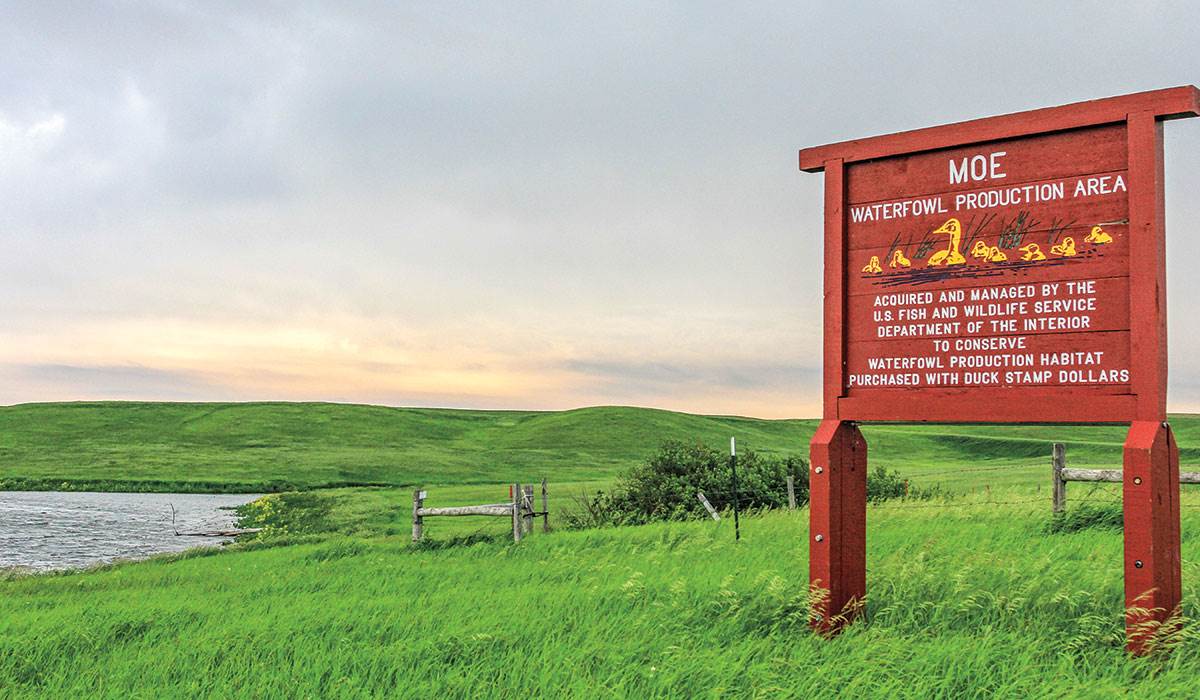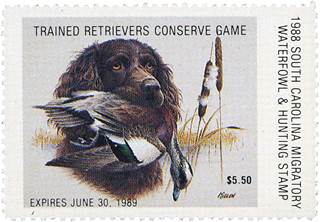Delivering for the Ducks
Duck stamp revenues provide crucial funding for wetlands and waterfowl conservation
Duck stamp revenues provide crucial funding for wetlands and waterfowl conservation
By Jennifer Boudart

Duck stamps are as much a part of the waterfowl hunting tradition as decoys, waders, and calls. Everyone age 16 and older must purchase a federal duck stamp to hunt waterfowl in the United States. This legal requirement has been in place for nearly 90 years, thanks to the Migratory Bird Hunting and Conservation Stamp Act of 1934 (also known as the Duck Stamp Act). Proceeds from the sale of duck stamps are used by the US Fish and Wildlife Service (USFWS) to secure waterfowl habitat for inclusion in the National Wildlife Refuge System. Today, the federal duck stamp is recognized as one of the most engaging, efficient, and effective ways to support conservation anywhere in the world.
On average, 1.5 million duck stamps are sold each year, yielding nearly $40 million in proceeds. Waterfowlers buy most of these stamps, but anyone can purchase them. They are popular with bird-watchers, art and stamp collectors, outdoor enthusiasts, and other conservation-minded citizens. The stamps are highly collectible and can also be used for free admission to public national wildlife refuges.
Ninety-eight cents of every duck stamp dollar are spent directly on protecting habitat. To date, federal duck stamps have generated over $1.1 billion to conserve more than 6 million acres of waterfowl habitat nationwide. Duck stamp dollars have helped to create or expand more than 300 national wildlife refuges and have positively impacted at least one refuge in every state. These public lands benefit not only waterfowl but also hundreds of fish and wildlife species, including one-third of species identified as threatened or endangered. In addition, many national wildlife refuges are open for public hunting and other outdoor recreation activities, including fishing, bird-watching, hiking, paddling, and wildlife photography.
All proceeds from federal duck stamp sales are deposited in the Migratory Bird Conservation Fund (MBCF), which was also established by the Duck Stamp Act. Duck stamp dollars typically account for 40 to 50 percent of funds in the MBCF; import duties collected on arms and ammunition are another major funding source. In 2021, more than $97.5 million from the MBCF protected roughly 90,000 acres of wildlife habitat across 14 states.
The Small Wetlands Acquisition Program (SWAP) was created in 1958 to protect small wetlands and associated grasslands for breeding waterfowl. The program is primarily delivered in the Prairie Pothole Region of Iowa, Minnesota, Montana, North Dakota, and South Dakota. More than 3.3 million acres of habitat have been added to the refuge system through SWAP, and duck stamp dollars have been a key funding source. In fact, when the price of the duck stamp was raised from $15 to $25 in 2014, the Duck Stamp Act was amended so that all revenues in excess of $15 from each stamp sold must be spent on this program.
Through SWAP, the USFWS acquires land to serve as waterfowl production areas, which are open to the public for hunting and other forms of outdoor recreation. The USFWS also purchases conservation easements from willing landowners through this program. These voluntary working-land easements permanently protect wetlands from being drained and grasslands from being plowed. These easements also provide financial benefits to landowners, who continue to own and use the property.
For decades, Ducks Unlimited has partnered with the USFWS to help landowners secure conservation easements. Randy Renner coordinates this effort as manager of conservation programs for land protection in DU's Great Plains Region. "A big part of what our conservation and realty specialists do is to help develop interest in easements among private landowners," Renner explains. "We also do a biological evaluation of each property and work with the landowner to come up with an ideal agreement for all parties involved." Renner says DU and the USFWS process over 500 easement contracts annually.
Moreover, DU uses its own philanthropic dollars to directly purchase easements that are then donated to the USFWS. These funds come from major donors, corporate sponsors, foundations, and other participating nongovernmental organizations. DU applies for North American Wetlands Conservation Act (NAWCA) grants and other public funding to complement these philanthropic contributions.
Federal duck stamp revenues are also used to expand the National Wildlife Refuge System through the purchase of land in predefined "acquisition boundaries" around each refuge. In 2021, MBCF dollars funded the purchase of 9,000 acres to expand refuges in eight states. Additional purchases are made using funds from NAWCA and the Land and Water Conservation Fund.
If there's a short window of opportunity to make a property purchase, the USFWS may engage a partner to buy the land and hold it while the agency works on the closing. DU has realty specialists on staff who work with the USFWS for this purpose.
Jerry Holden is senior director of operations in DU's Southern Region, where land acquisitions with the USFWS are in development in Arkansas, Florida, Louisiana, Texas, and Virginia. Holden explains that DU typically takes out a loan that is financed through the seller or through a bank. "Once DU has the land, we often lease it to the USFWS so they can begin managing it for the public trust as though it were theirs until we make it theirs."
When the USFWS is ready to purchase the land, duck stamp dollars or other funds flow to DU. The loan gets paid off, but funds don't go toward any interest or closing costs. DU covers those costs with gifts from foundations, major donors, and corporate partners. "Putting land in the public trust is widely understood to be a fundamental conservation good," Holden says. "So, there are people who want to help make that happen, and we're thankful for their generous support."
Holden stresses that everyone, whether they hunt or not, should buy a duck stamp each year. "We all benefit from public lands. So, buy a duck stamp-actually, buy two and do twice the good. It's a great investment for our kids and grandkids."

Many states require waterfowl hunters to purchase a state duck stamp in addition to a federal stamp. State duck stamp dollars often have a significant local impact by funding statewide wetland conservation projects and programs, but in many states these dollars have a significant international impact as well. The Fall Flights program, which is administered by the Association of Fish and Wildlife Agencies (AFWA), is a crucial funding source for conservation work in Canada. Most participating state agencies use band recovery data to target their contributions specifically in the provinces that produce the majority of the waterfowl that visit their states.
For its part, Ducks Unlimited matches every dollar contributed by state agencies and works with DU Canada to match those contributions with North American Wetlands Conservation Act grants and Canadian partner funds. Through this process, contributions from state agencies may be multiplied five or six times over. Since the Fall Flights program's inception, state wildlife agencies have contributed more than $88 million to help conserve over 4.2 million acres of waterfowl habitat in Canada. Just last year, 43 states contributed a record $4.6 million. One of AFWA's goals is to achieve 100 percent state participation by 2026.
Ducks Unlimited uses cookies to enhance your browsing experience, optimize site functionality, analyze traffic, and deliver personalized advertising through third parties. By continuing to use this site, you agree to our use of cookies. View Privacy Policy